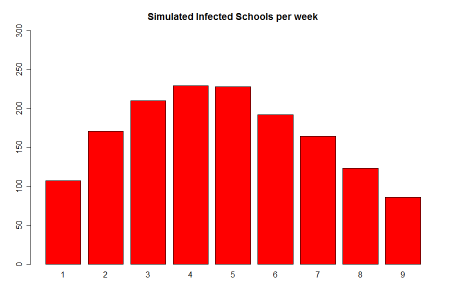Simulation
Now, with possible values for our parameters, the basic idea is to simulate our model and see if we are able to recover our original data.
First, we simulate our three parameter model. The results are shown in the next graph:
Since, its peak is considerably below the actual epidemic we decided to include the extra parameter and
to increment the amount of infected schools:
- The
parameter will detect external pressure to the schools, increasing the value of
as already explained on the model section. This will increase the amount of schools infected at each week.
- The
parameter will control the shape of the infectious period of school
,
, which originally was considered as a Geometric(
) random variable, that is the discrete equivalent to the exponential distribution. Now, it is a Negative Binomial (
,
), that is the discrete equivalent to the Gamma distribution. The main idea of this, is to reduce the probability assigned to lower values of
and increase the probability of higher values. In that way, schools are more likely to stay infected for a longer period.
Now, consider this 5 parameter model, we obtain the following graph:
Finally, we were also available to illusrate the evolution of this simulated epidemic through time:
Key:
Blue - Susceptible
Red - Infected
Green - Recovered
For quantitative results one could look at:



